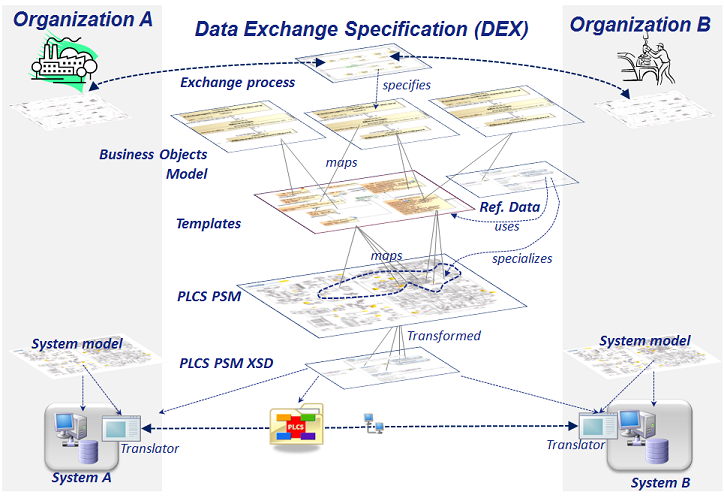




This document provides the FunctionalStructure DEX Data Exchange Specification (DEX).
The DEX:
- identifies a subset of the ISO 10303-239 "Product Life Cycle Support" information model that is to be used in a given business context;
- provides usage guidance for how ISO 10303-239 PLCS is to be used.
ISO 10303-239 is part of the ISO 10303 (STEP) set of International Standards for the computer-interpretable representation of product information and for the exchange of product data. The objective of ISO 10303 is to provide a neutral mechanism capable of describing products throughout their life cycle. This mechanism is suitable not only for neutral file exchange, but also as a basis for implementing and sharing product databases, and as a basis for archiving.
ISO 10303-239 PLCS - Product Life Cycle Support specifies an information model that defines what information can be exchanged and represented to support a product through life. Examples of such information are:
- information for defining a complex product and its support solution;
- information required to maintain a complex product;
- information required for through life Configuration Management of a product and its support solution.
The principle components of a DEX and their relationships are summarized in Figure 1. This shows the DEX in the center of the figure, with the DEX being used by two organizations A and B as the mechanism for the exchange.
The DEX provides a specification of how the PLCS PSM is used to support the exchange of data for a specific set of business requirements. The PLCS PSM is a SysML model with an associated XML Schema that defines data to be exchanged.
The DEX identifies a high level data exchange process that identifies the process triggers that will initiate a data exchange. For example, a maintenance request. The process is documented by identifying the exchanges in the Activity Model. The process may also be documented separately as a process model.
The information that is exchanged is first documented in the DEX as a Business Object model. This uses business terms to precisely specify the possible content of any exchange. The scope and content of the model is driven by the process model.
Having defined the Business Objects, the usage of the PLCS PSM to represent the Business Objects is then defined. That is the Business Objects are "mapped" to the PLCS PSM. This mapping is formally represented by Templates. Each Business Object will have a corresponding Template that specifies how the Business Object is represented using the PLCS PSM. In practice, the scope of DEXs will overlap, with similar business objects repeatedly using the same PLCS PSM constructs. Hence Templates are potentially reused by multiple DEXs.
As well as specifying how the PLCS PSM is used to represent a business object, a Template may identify the Reference Data that is applied to PLCS PSM. That is the Reference Data necessary to apply more precise semantics to the PLCS PSM in order that the business object is precisely mapped.
Having mapped the business object to the PLCS PSM, the complete subset of the PLCS PSM that is required by the DEX is identified and a corresponding XML Schema created. This XML Schema along with the Templates then provides the specification for translators that read and write the DEX data sets into the relevant systems. The XML Schema is also used to validate DEX data sets.
Further information about PLCS and DEXs is available in the help sections. Namely:
- PLCS introduction;
- PLCS technical overview;
- Data Exchange Specifications (DEXs);
- Templates;
- Reference Data (RD).
The Functional Structure DEX enables the exchange of agreed Functional (Breakdown) Structure Information between the supplier and the Swedish Defence Materiel Administration (FMV) using a standardized data exchange format (PLCS PSM XML).
The DEX comprises the following sections:
- Terms provides a definition of terms used in this DEX;
- Scope outlines the scope of the information covered by the DEX;
- Business Overview provides a high level overview of the business process / application that this DEX is intended to support;
- Business Information Overview provides a high level overview of the business information that can be represented by this DEX;
- Business Information Model provides a more detailed overview of the information that the business process / application described in Business Overview requires;
- PLCS PSM Representation provides technical details of how the business information requirements identified in Business Information Model are represented using PLCS PSM;
- Example data sets lists a set of example XML datasets that have been instantiated in accordance with this DEX.
- Templates lists all the templates that are used in the definition of this DEX;
- Schemata identifies the schemata that define this DEX. The overarching schema is the PLCS PSM. The DEX specifies subsets of this schema that are to be used for a specific exchange purpose.
- Reference Data lists the reference data classes used by this DEX;
- Conformance defines the requirements for applications to conform to this DEX.

